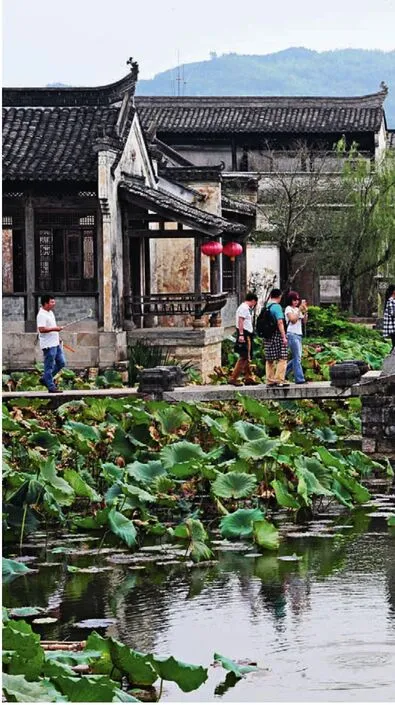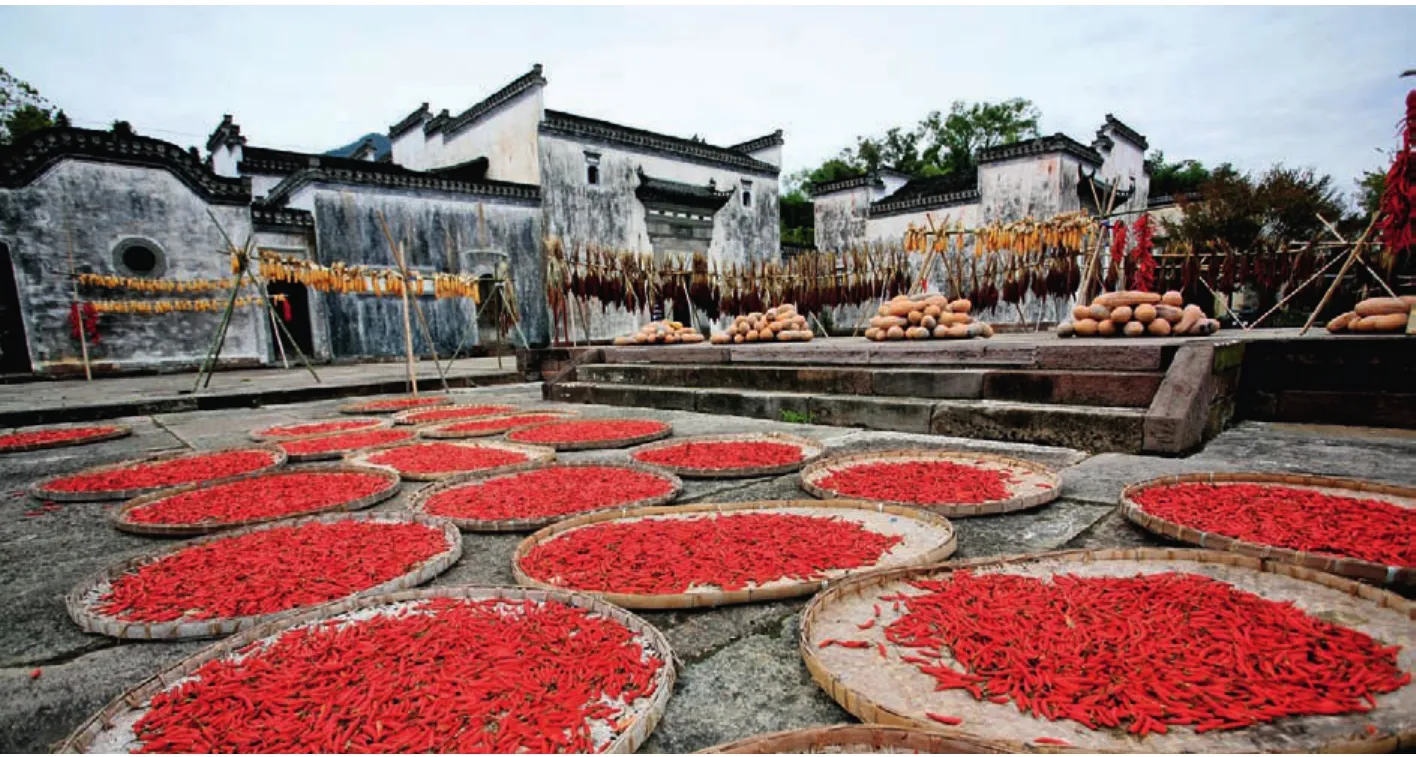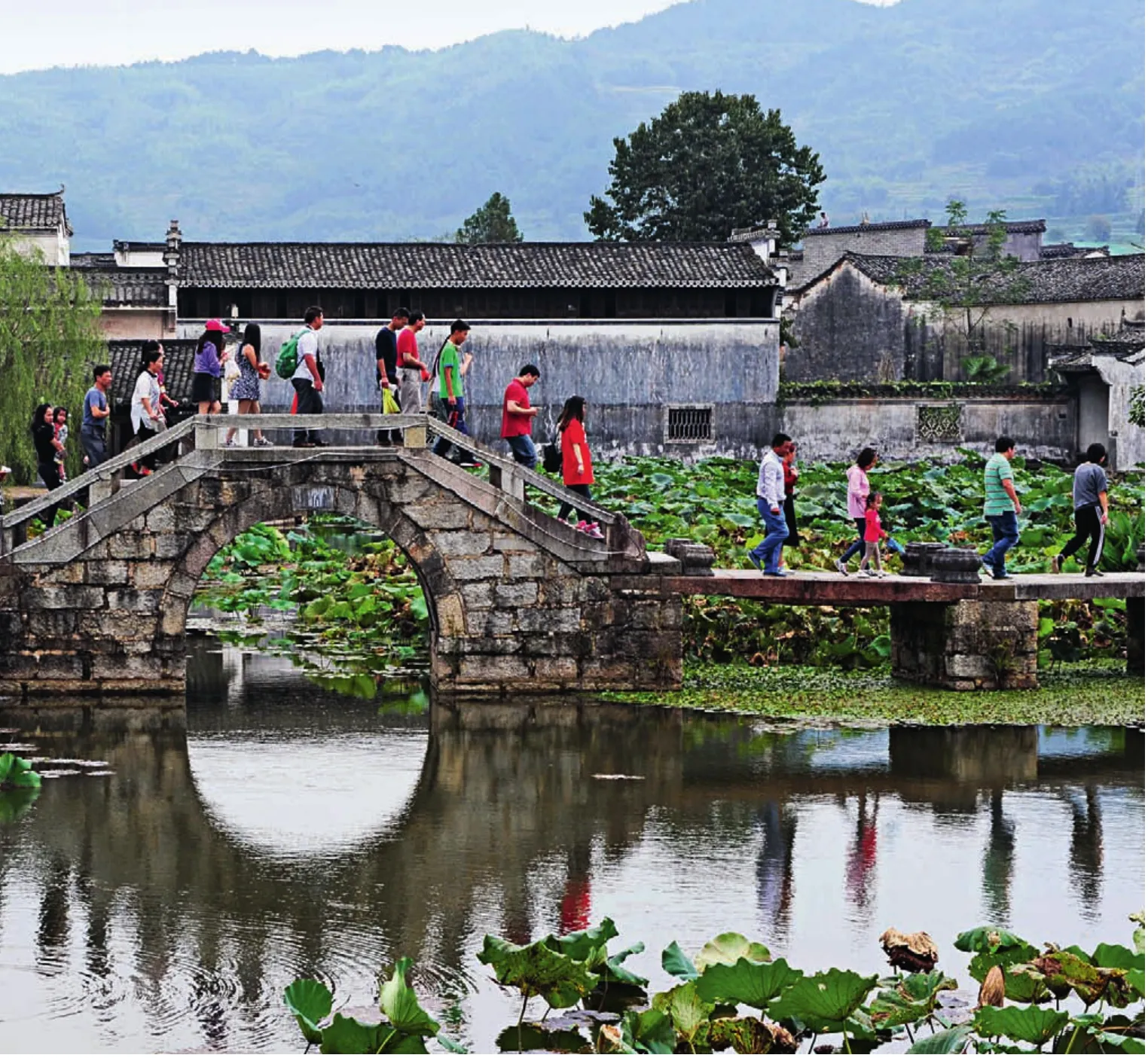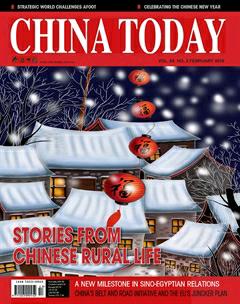Leisurely Life in Ancient Chengkan Village
By LI JINGWEN & ZHANG KE
Leisurely Life in Ancient Chengkan Village
By LI JINGWEN & ZHANG KE
T HE Internet has rejuvenated our old village,” Luo Qing said. “It has brought in more tour ists an d m ade tr avel more convenient.” A Chengkan native, Luo has worked at the village’s tourism company for 15 years. “Tourists used to rush from one scenic spot to another, but have since slowed down so as to truly experience life in the countryside,” Luo said.
Luo Qing cooperates with big tourism portals like Ctrip and Qunar, which generate an average 70 percent occupancy of her inn. “We’re almost booked solid for Spring Festival,” Luo said. She and her elder sister spend all their spare time renovating another house built in the Ming Dynasty (1368-1644) by a prefecture chief. They are trying to complete the project by spring and so accommodate the soaring numbers of tourists during the May Day vacation. Her younger brother also runs a village lodge called Xingde Hall. “The village has more than 10 inns of different levels and scales, and several more are opening this year,” Luo Qing said.
Located in Huizhou District, Huangshan City of Anhui Province, Chengkan is only 30 km away from the bustling downtown area. But it is still a tranquil setting, and famed as one of the best preserved Ming Dynasty villages. Chengkan is site of more than 150 buildings from the 14th to early 20th centuries, among which 21 are on the list of nationally protected items.
The 1,800-year-old Chengkan is a typical Huizhou village on the banks of Yongxing (Eternal Prosperity) Lake. Houses are whitewashed with lime that has mottled over time, and the closely aligned ivy-covered horsehead gables rising in steps above the roofs form the village’s districtive skyline. Winding narrow streets paved with polished blue stone connect the 600 households.
At the southern tip of the village stands a mansion by the river. Its high arched gate signifies the unusual status of its creator Luo Yinghe (1540-1630), vice minister of finance during the Ming Dynasty. Luo Qing and her family now live here, and are responsible for keeping it in good order. As she said, “This is our ancestor’s house, so we have deep feelings for it.” Luo has set aside several rooms for tourists. “They have the chance to stay with us in a real old house and experience a life as leisurely as that of our ancestors,” Luo said.


Freshly harvested red chillis dry in the sun.
Baolun Pavilion is another mustsee building. First constructed in 1542, shortly afterwards the building underwent the 70-year-long extension that made it the ancestral hall of the Luo clan, located on Chengkan Village’s highest point. Covering over 3,000 square meters, the ancestral hall consists of three courtyards. Its horse-head gables in which as many as five steps are embedded signify the family’s wealth and honor. This is one of the few preserved Ming civilian dwellings in China. The essence of the timber structure building is apparent in its fine wood and brick carvings, and plaque inscribed by master calligrapher Dong Qichang.
The top of the Baolun Pavilion offers a panoramic view of the mountains encircling the village and the terraced fieldsand farmland between them. As many brooks and streams flow down to the village, bridges in various styles are a main feature. The oldest, Huanxiu Bridge, was built during the Yuan Dynasty (1271-1368). Longxing Bridge is a stone arched bridge with the longest single-span in the Huizhou area. The village alleys are narrow and winding, making it a giant maze in which travelers often get lost until locals set them on the right path.

Chengkan is a popular tourist destination.
Chengkan was built according to fengshui theory, which originates in the Yi Jing, or Book of Changes. The Luo brothers, who founded the village, were reputedly fengshui masters. They are believed to have chosen this place for their offspring because it is backed by mountains and faces a screen of hills, with several brooks flowing through. They changed the original name Longxi (dragon rivulet) to Chengkan. They selected both characters from the Book of Changes. Cheng means yang (active, or bright) while Kan means yin (passive, or shadowy). The Luo brothers believed that yin and yang interaction would create a state of harmony that would bless their offspring.
The eight hills around the village coincide with the Eight Trigrams, symbol of fengshui. The Longxi River meanders through the village from north to south like a big S that appears as the curve separating yin from yang at the center of the Eight Diagrams. Two ditches channel water from rivers and brooks to every household, so providing daily water usage as well as that needed for drainage, irrigation, and to extinguish fires.
The inception and prosperity of Chengkan is closely related to Huizhou businessmen. This group of entrepreneurs became active in the Song Dynasty (960-1279) and reached their heyday in the Ming and Qing dynasties. At that time they controlled business in the middle and lower reaches of the Yangtze River, the nation’s wealthiest region. Huizhou Prefecture (now Huangshan City) has long been immersed in Confucianism as it was the ancestral hometown of Song Dynasty Neo-Confucianists Cheng Hao, Cheng Yi and Zhu Xi. Huizhou businessmen hence set great store by education, ancestor worship, and the principle of family clans. After achieving commercial success, they shared these profits with their hometowns by renovating old houses and undertaking public constructions such as schools, ancestral halls, memorial archways and gardens in the village. During the process of construction they were also lavish with carvings, paintings, plaques and other decorations that reflect the temperament and interests of Confucian scholars. Many Huizhou villages, well preserved even today, were perceived as icons of traditional society and the poetic idyllic life that modern urbanites now crave.
The house on which Luo Qing worked had just undergone a two-year renovation that cost more than RMB four million. It looks almost the same, as regards structure and ornamentation, as it did originally. Traditional ornaments and daily-use items, such as the well, corridor, pavilion, and old vines, have been retained. But bathrooms have been added for the comfort of tourists. At lunch time, a visitor from Jiangsu Province cooked on the old adobe hearth. “It’s wonderful to cook for myself!” he said. “My host has made this old building a warm and welcoming home. We enjoy meals cooked from fresh food ingredients while listening to old stories about the house and village.”
In light of new tourism trends, the local government, along with the village’s tourism company, has explored practical ways of developing tourism while at the same time preserving ancient buildings. They have attracted investment and encouraged villagers to open lodges and inns in their old houses. Aware of the inestimable cultural value of these relics, they voluntarily protect these old houses for the benefit of future generations.
In 2014, Chengkan was listed as exemplar of the national heritage protection project and pilot for a national ancient village protection project. The village invited professional renovation teams to carry out all-round refurbishment of old buildings according to the concept of restoring them in their original style. They also conducted moth proofing treatment and improved the fire-fighting equipment and lightning conductors. Thus far, the first stage of the project involving 10 old buildings has been completed. The launch of the second stage is in the offing.
LI JINGWEN & ZHANG KE are public servants at the Huizhou District Government, Huangshan City, Anhui Province.

